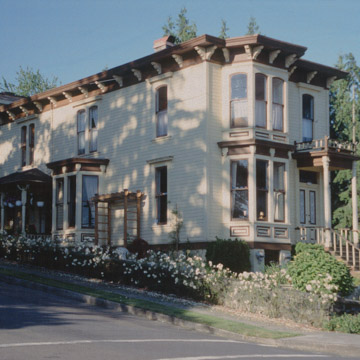The Judge C.H. Page House is one of the high-end residences built when Astoria was at its most prosperous. Captain Hiram Brown commissioned the house in 1879 as a wedding gift for his daughter, Annie, when she married his one of his business partners, Charles H. Page, who was also a member of the city council, proprietor of a general store, and had recently become a lawyer.
The two-story house was built on a narrow and steeply sloped lot on the southwest corner of Fourteenth Street and Franklin Avenue, adjacent to Brown’s own property. The Italianate structure’s verticality is enhanced by the high basement foundation and the two-story bay window on the main facade (the rear of the house is at ground level), as well as the tall and narrow windows throughout the rest of the house. Over the years, the house has been variously painted in contrasting hues that bring out its strongly articulated detailing, especially in the boldly projecting uppermost cornice, which is supported by extremely large brackets. As originally built, the house consisted of a front and back parlor, a one-story dining room wing at the rear, plus a lean-to kitchen on the south end; the second floor contained three bedrooms.
Page became a prominent business and political figure in Astoria, and in 1891, he and Annie commissioned an opulent Queen Anne mansion on the south end of the block (at Fourteenth Street and Grand Avenue). Their original house was enlarged to its current dimensions at some point between 1892 and 1896 to accommodate its new role as a boarding house. A two-story rear addition, built circa 1898, was later removed in 1903 by new owners Charles and Helen Houston, who relocated it seventeen feet to the south and finished it as a separate residence that is still extant today.
The house continued to serve a variety of purposes. From 1932 to 1942, the Astoria Business College occupied the house. During World War II, it once again became a boarding house and by the 1960s had deteriorated. When Vera Whitney Gault assumed ownership of the house in 1966, she initiated a restoration that returned the house to its early-twentieth-century appearance. Today, the Judge Page House remains of the best examples of Astoria’s Italianate architecture.





